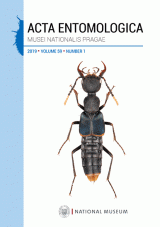A review of Thysanarthria with description of seven new species and comments on its relationship to Chaetarthria (Hydrophilidae: Chaetarthriini)
Fikáček Martin, Liu Hsing-Che
Acta Entomologica Musei Nationalis Pragae 59(1): 229-252, 2019
Published online: 20th June 2019
Published in print: 10th August 2019
Views: 1377
Abstract: The Old World genus Thysanarthria Orchymont, 1926 is reviewed taxonomically and
compared to the related genus Chaetarthria Stephens, 1835. Chaetarthria is
considered to consist of three groups differing in the morphology of male
genitalia and surrounding sclerites: (1) large Old World Chaetarthria which
seems to stand apart of the remaining groups, and (2) European Chaetarthria
plus (3) American Chaetarthria which both share the male sternite 8 with a long
median projection with Thysanarthria. The reduced mesal part of male sternite 9
is shared by European Chaetarthria and Thysanarthria, supporting their close
relationship proposed by previous molecular analyses. Sixteen species are
recognized within Thysanarthria which differ in the details of the morphology of
the aedeagus illustrated for all species. Seven species are described as new: T.
bifida sp. nov. (Thailand), T. cardamona sp. nov. (India: Kerala), T. chui sp.
nov. (Taiwan), T. persica sp. nov. (southern Iran), T. saurahana sp. nov.
(Nepal), T. trifida (Laos), and T. wadicola sp. nov. (Oman). New records are
provided for T. ceylonensis Hebauer, 2001 (new to India: Madhya Pradesh), T.
championi (Knisch, 1924) (new to Afghanistan, India: Arunachal Pradesh, China:
Yunnan, and Myanmar), T. madurensis Hebauer, 2001 (new to Nepal and India:
Kerala), and T. siamensis Hebauer, 2001 (new to India: Uttarkhand, Nepal and
Laos). Chaetarthriomorphus sulcatus Chiesa, 1967 is revealed as a junior
synonym of Chaetarthria championi Knisch, 1924, and lectotypes are designated
for both these taxa. An undescribed species of the American group of
Chaetarthria is recorded from Saudi Arabia either as an accidental introduction
or due to mislabeling; the species is illustrated but not described.
Key words: Hydrophilidae, Chaetarthriinae, Thysanarthria, Chaetarthria, systematics, distribution, new species, new records, lectotype designation, genitalia morphology, introduced species
Papers
Three endemic Aphaenogaster from the Siculo-Maltese archipelago and the Italian Peninsula: part of a hitherto unrecognized species group from the Maghreb? (Hymenoptera: Formicidae: Myrmicinae)A new species of the myrmecomorphic planthopper genus Formiscurra (Fulgoroidea: Caliscelidae) from EthiopiaTaumacera revisited, with new synonyms, new combinations and a revised catalogue of the species (Coleoptera: Chrysomelidae: Galerucinae)Neolimnophila alaskana (Alexander, 1924) stat. nov., a species new to the Palaearctic Region (Diptera: Limoniidae)Description of Gondwanoscurus curleri sp. nov. from the West Usambara Mts, Tanzania (Diptera: Psychodidae)A new species of the genus Brachycoleus (Hemiptera: Miridae), with a revised identification key to the species found in IranTaxonomic review for the Asian taxa of plant bug tribe Hallodapini, with emphasis on stridulatory mechanism (Hemiptera: Heteroptera: Miridae)Cretobrachygluta gen. nov., the first and oldest Brachyglutini in mid-Cretaceous amber from Myanmar (Coleoptera: Staphylinidae: Pselaphinae)First Sphaeroceridae (Diptera) endemic to Madeira – three new terricolous species of Spelobia and PullimosinaNew taxa of Neotropical Coreidae of the tribes Acanthocerini and Nematopodini (Hemiptera: Heteroptera)On the genus Philomyceta of China (Coleoptera: Staphylinidae: Staphylininae)Morphology of bromeliad-associated immature stages of Daiphron bipartitus and its adults confirms the non-monophyly of the genus (Coleoptera: Cantharidae)Leaf litter and moss-inhabiting flea beetles of Hong Kong (Coleoptera: Chrysomelidae: Alticini)The genus Harmonia (Coleoptera, Coccinellidae) in the Middle East regionStudies of the genus Anthelephila Hope (Coleoptera: Anthicidae). Part 19. New species from Indonesia and MalaysiaA new species and a new record of the genus Scymbalopsis (Coleoptera: Staphylinidae: Paederinae: Paederini)New taxa and new records of Erythroneurini from China (Hemiptera: Cicadellidae: Typhlocybinae)Discovery of the genus Airaphilus (Coleoptera: Silvanidae) in Japan, with a description of a potentially endangered new speciesThe first hygropetric Platynectes and its larva from eastern China (Coleoptera: Dytiscidae)A review of Thysanarthria with description of seven new species and comments on its relationship to Chaetarthria (Hydrophilidae: Chaetarthriini)Aquatic Coleoptera of North Oman, with description of new species of Hydraenidae and HydrophilidaeA review of the Barsine perpallida-B. yuennanensis species-group, with descriptions of six new species (Lepidoptera: Erebidae: Arctiinae)Two new species and ten new records of Heteroptera from Turkey, including the first record of the potential alien Campylomma miyamotoi in the Western PalaearcticA review of the genus Olophrinus from China (Coleoptera: Staphylinidae: Tachyporinae)Two new species of Rohdendorfi a (Diptera: Syrphidae) from Central AsiaFirst Mexican record of Neoarisemus maesi with the description of the female (Diptera: Psychodidae)Discovery of termitophilous tenebrionid beetles in China (Coleoptera: Tenebrionidae) 